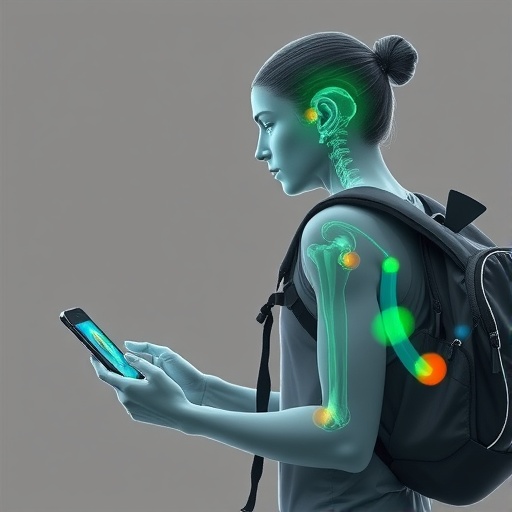Recent studies have brought to light the complex dynamics between smartphone usage, carrying loads such as backpacks, and their biomechanical effects, which may differ based on gender. This research is particularly relevant in an era where mobile devices have become ubiquitous, heralding both convenience and potential health risks. Researchers Chen, Tang, and Guan have conducted an investigation that delves into how these variables interact during both standing and walking scenarios, with a particular focus on gender-specific responses.
The findings indicate that the act of using a smartphone while carrying a backpack poses unique biomechanical challenges. For both men and women, the combination of a device tethered to our daily lives and the physical weight of a backpack can alter posture and gait significantly. This interaction can lead to muscle fatigue and increased strain on various joints, highlighting the necessity for ergonomically-friendly solutions as digital device usage continues to rise.
Interestingly, the study reveals that the impacts of smartphone use while burdened with a bag might not affect genders equally. Women often displayed different biomechanical patterns than men when engaged in similar activities, suggesting that anatomical and physiological differences could influence how they manage the additional load during smartphone use. Understanding these variations is crucial for developing gender-specific recommendations aimed at reducing musculoskeletal issues exacerbated by modern technology.
In order to appreciate the significance of this research, we must consider the increasing reliance on smartphones for virtually all age groups and lifestyles. Smart devices are not merely communication tools but are integral to our work, social interactions, and even learning processes. The constant interaction with these devices has implications beyond convenience; it strains the body in myriad, often unnoticed, ways.
The dual use of smartphones and backpacks highlights an area of public health that has not yet been adequately addressed. As individuals traverse their daily environments, whether commuting or during longer walks, the interaction between pouches full of items and the notifications that beckon our attention demands a careful examination of body mechanics and overall health. These moments may seem inconsequential, yet cumulative exposure to poor postural habits can lead to chronic conditions, pain, and decreased quality of life.
Additionally, the study draws connections to previous literature on posture and device usage, stressing that the need for awareness surrounding device-usage ergonomics is paramount. As we integrate technology into every facet of our day, it’s imperative that we adapt our physical habits to prevent adverse health outcomes. This is not merely an individual concern—public health policies might need to prioritize education on mobile device ergonomics to mitigate risks for future generations.
Consider the scenarios of daily life where people interact with their smartphones: waiting in lines, walking on campus, or even exercising. Each of these activities calls for adaptation as the user juggles physical load and digital engagement. The combination of multitasking within a busy lifestyle brings forth questions about the long-term effects if these behaviors remain unchecked, notably in young people whom the study identifies as particularly vulnerable.
The research also touches upon the psychological elements intertwined with device usage. The tendency to check devices frequently or become distracted could lead to compromised posture and increase the risk of dropping or improperly supporting the backpack. Users may become less aware of how their bodies position themselves in relation to their environments, leading to additional injuries or discomfort.
Thus, the study prompts essential conversations about the necessity of mindfulness in everyday behaviors. It encourages readers to think critically about their practices concerning both physical load management and their reliance on technology. As awareness grows, it may inspire individuals to cultivate healthier habits, allowing them to leverage the advantages of technology without neglecting their physical well-being in these interactions.
Furthermore, technology companies and ergonomic experts could collaborate to design backpacks and smartphone accessories that take these findings into account. Innovations in design could potentially lessen the biomechanical strain users face when balancing device interactions and physical loads. Such advancements would benefit all users, particularly individuals who are frequently on the go, by prioritizing their health.
Through ongoing research into these interactions, we can foster a deeper understanding of how modern devices impact our physical health. The insights gained can contribute to developing strategies to promote healthier, more sustainable use patterns in our increasingly technology-driven environments.
This research stands as a starting point for further exploration into how mobile technology can evolve alongside our understanding of human biomechanics. By shedding light on gender-specific responses to these common activities, we can better inform design, policy, and usage patterns that align with healthy living.
The implications extend beyond individual health, potentially influencing workplace environments, educational institutions, and public transport systems. When we understand the factors affecting our physical state while engaged with technology, we can better integrate solutions to preserve our health and overall functionality in a digital world.
In conclusion, the study emphasizes the intricate dance between our increasingly gadget-laden lives and the physical repercussions of such modern behaviors. The need for awareness, delivery of ergonomic solutions, and educational initiatives is evident as we strive towards a balanced coexistence with our devices.
Subject of Research: The biomechanical effects of smartphone usage with backpack load during standing and walking, considering gender differences.
Article Title: Gender-specific biomechanical effects of smartphone use with backpack load during standing and walking.
Article References:
Chen, YL., Tang, WH. & Guan, YX. Gender-specific biomechanical effects of smartphone use with backpack load during standing and walking. Sci Rep 15, 36091 (2025). https://doi.org/10.1038/s41598-025-20015-8
Image Credits: AI Generated
DOI: 10.1038/s41598-025-20015-8
Keywords: Biomechanics, smartphone usage, backpack load, gender differences, posture, ergonomics, health risks, musculoskeletal issues.
Tags: anatomical differences in load managementbackpack load health risksbiomechanics of standing and walkingergonomic solutions for mobile device usersgender differences in biomechanicsgender-specific responses to backpack loadsimpact of carrying loads on jointsmobile device ergonomicsmuscle fatigue from smartphone useposture and gait changessmartphone addiction and physical strainsmartphone usage biomechanics





